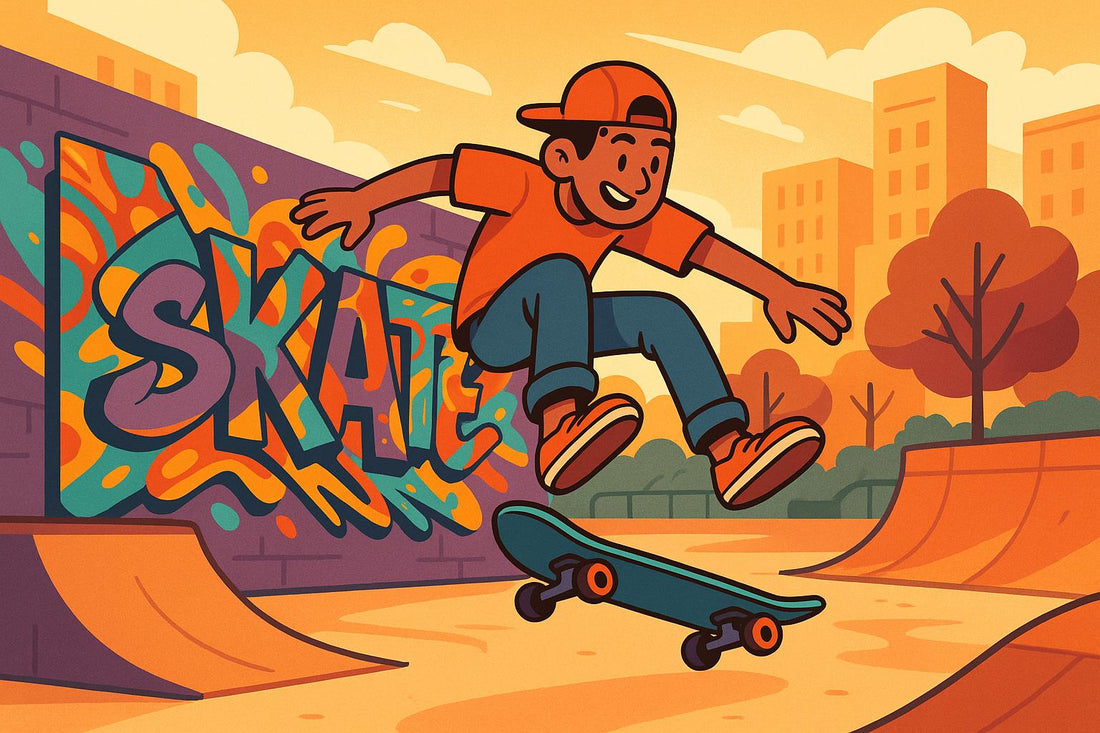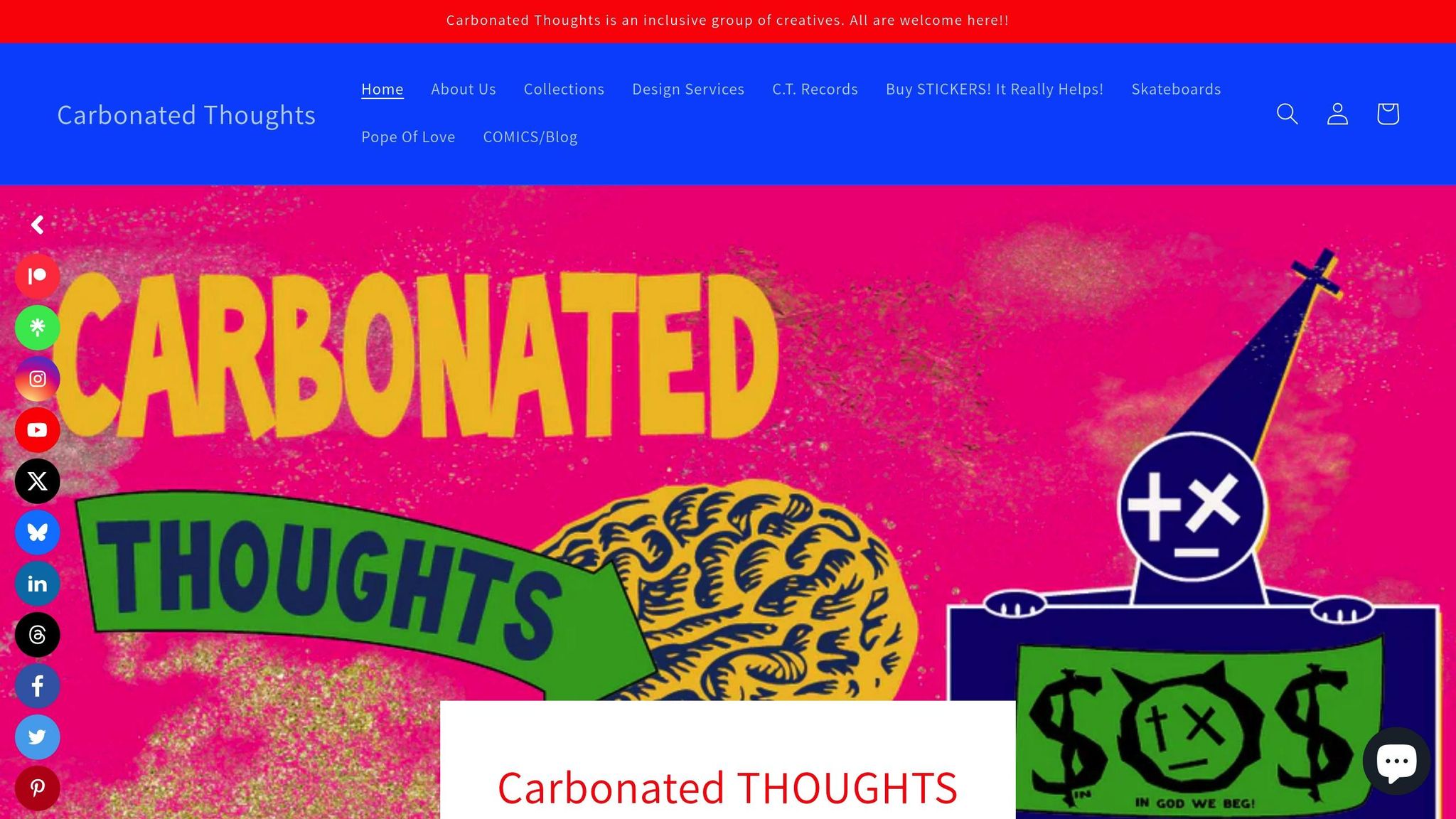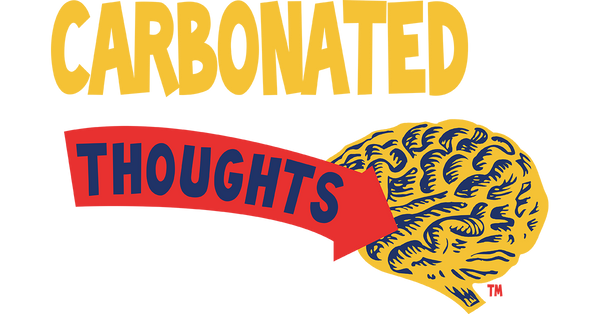
Skateboarding vs. Street Art: A Shared Space
Share
Skateboarding and street art transform urban spaces into hubs of creativity and self-expression. Both started as rebellious subcultures - skateboarding emerged in 1950s California as "sidewalk surfing", while street art began with graffiti tags in the 1960s. Today, they overlap in shared public spaces, blending movement and visual art to redefine how cities are experienced.
Key Points:
- Skateboarding: Originated from surfing, emphasizes personal style, and reimagines architecture for tricks. Now a global sport with 1,500 skateparks in the UK alone.
- Street Art: Began with graffiti, challenges societal norms, and evolves into public and gallery art. Artists like Banksy use it to provoke thought.
- Shared Spaces: Skateparks often feature murals, while urban areas like San Francisco's U.N. Plaza show how art and activity can reduce crime and increase community use.
- Cultural Impact: Both movements thrive on DIY ethos, creativity, and pushing boundaries. They face legal challenges but continue to reshape public perceptions.
Quick Comparison:
| Aspect | Skateboarding | Street Art |
|---|---|---|
| Origins | Surfing-inspired in 1950s California | Graffiti in 1960s Philadelphia |
| Expression | Personal style, tricks | Public messages, visual art |
| Public Perception | Seen as disruptive by some | Increasingly embraced in urban culture |
| Legal Status | Restricted in public areas | Ranges from illegal to commissioned |
| Shared Spaces | Skateparks with murals | Urban walls and public structures |
Skateboarding and street art share a rebellious spirit and a passion for urban spaces, proving that creativity can transform how we interact with cities.
Origins and Growth
Skateboarding: From Surfing to Streets
Skateboarding’s journey began on the sunny beaches of California before rolling its way into streets worldwide. In the 1950s, surfers looking for something to do on calm, wave-free days came up with "sidewalk surfing" by attaching roller skate wheels to wooden boards. This do-it-yourself spirit became a defining characteristic of skateboarding, as Powell-Peralta co-founder George Powell described:
"Skateboarding has been a DIY activity from its earliest beginnings in California. Imagine it yourself, build it yourself, play on it yourself, create your own style and tricks yourself, without controls, coaches, or rules, and happily it still is. That's why it is still fun."
By the mid-1960s, skateboarding was booming, with manufacturers producing around 50 million skateboards between 1963 and 1965. Key developments propelled the sport forward: the invention of the kicktail in 1969, which allowed for more advanced tricks, and the introduction of polyurethane wheels in 1972, which offered better speed and control.
Street Art: From Tags to Museums
Street art also emerged as a form of rebellion and self-expression. In the late 1960s, Darryl "Cornbread" McCray began tagging his name across Philadelphia, turning graffiti into a personal statement. Around the same time, New York’s TAKI 183, a delivery boy, gained fame for writing his name all over Manhattan. His work caught the public’s eye after a 1971 New York Times article, inspiring countless others to pick up spray cans.
By the 1980s, artists like Jean-Michel Basquiat and Keith Haring brought street art into galleries, bridging the gap between the underground and the mainstream. The movement continued to evolve, with figures like Banksy pushing boundaries. His 2006 Disneyland installation - a life-sized inflatable doll dressed as a Guantanamo Bay prisoner - challenged societal norms and highlighted street art’s power to provoke thought. Banksy summed up the rebellious essence of graffiti:
"To some people breaking into property and painting it might seem a little inconsiderate, but in reality the 30 square centimeters of your brain are trespassed upon every day by teams of marketing experts. Graffiti is a perfectly proportionate response to being sold unattainable goals by a society obsessed with status and infamy. Graffiti is the sight of an unregulated free market getting the kind of art it deserves."
Underground Roots
Both skateboarding and street art were born out of defiance and a rejection of societal norms, carving their places in urban culture despite resistance. A 1965 New York Times article captured the tension surrounding skateboarding, quoting Mahwah Police Chief Edmund Wickham: "They scare the wits out of drivers and pedestrians".
Street art faced similar pushback, as cultural theorist Tea Hvala noted:
"Graffiti is a sporadic, illegal, mostly anonymous and fleeting form of intervention in the dominant culture...it becomes the most accessible medium of resistance, resistant to institutional control"
Despite these challenges, both movements thrived. They kept their rebellious edge while gaining mainstream acceptance. Patti McGee, the first professional female skateboarder, reflected on how skateboarding’s spirit endures:
"Back then and to this day, the culture of skateboarding remains a rebellious and wild culture that has a very special vibe that we hold dearly."
Shared Spaces and Influences
Streets as Canvas and Playground
Urban spaces often double as both creative canvases and playgrounds, where skateboarders and street artists reshape the environment into hubs of expression. These shared areas become living galleries, sparking innovation and fostering a sense of community. The very surfaces skateboarders glide across - whether concrete, walls, or other architectural features - frequently serve as the backdrop for striking street art.
Take San Francisco's U.N. Plaza, for example. In December 2023, the opening of a 13,000-square-foot skate plaza brought about tangible changes. Daytime drug-related incidents dropped by 64%, and average daily visitation increased by around 5% compared to the previous year. This example highlights how shared spaces can evolve into vibrant, multi-purpose hubs for both art and recreation.
Art on Decks and Parks
Skateparks have become prime locations for urban street art, with their broad concrete surfaces offering the perfect canvas for large-scale murals and installations. A standout example is the Artist Walk Skate Park in Jacksonville, designed with the vision of an art museum. It features three distinct "rooms", each with unique skating elements. As landscape architect Zachary Wormhoudt put it:
"Basically we built it like an art museum."
This blend of art and skating is deeply rooted in the culture itself. Bob Bass, a lifelong skateboarder, captures this connection perfectly:
"Skateboarding culture has always gone hand in hand with graffiti as an accepted form of expression, rebellion, and art. It's a culture thing, and that's probably the best answer you are going to get on that topic because it's the only logical explanation."
Carbonated Thoughts Projects

Building on this synergy between creativity and community, Carbonated Thoughts takes it a step further. For every skateboard sold, the company plants trees, turning their business into a force for environmental and social impact. Their custom deck designs, created by local artists, transform skateboards into mobile works of art. Beyond this, Carbonated Thoughts collaborates with skaters and artists to redesign public spaces, blending functionality with artistic expression.
One standout example of this approach is the Place de la République skate park in Paris. Artist Paolo Guidi partnered with Volcom to design a permanent structure that seamlessly integrated with its surroundings. Reflecting on the project, Guidi shared:
"We used skateboarding to show that you can think about public spaces differently. I wanted to show what's underneath that. Skating is beautiful and pure."
This fusion of art, skating, and community revitalization demonstrates the transformative potential of shared urban spaces.
Different Values and Public Views
Personal vs. Group Expression
Skateboarding often highlights personal style and individuality, while street art tends to amplify a collective voice. For example, in Bogotá, public approval of artistic graffiti's role in improving urban spaces surged from 38% in 2014 to 67% in 2015. This shift points to a growing awareness of how street art can foster social dialogue and community connection.
Meanwhile, skateboarding continues to face mixed public perceptions. Jess, a skateboarder, critiques these attitudes:
"Saying that you are committing an offence when you are skateboarding in town is like saying that you can't jog into town or you can't like hold a football or something."
These differences in how skateboarding and street art are expressed influence how society reacts to and regulates them.
Rules and Recognition
The legal and social standing of skateboarding and street art highlights contrasting societal attitudes. Here's a side-by-side comparison:
| Aspect | Skateboarding | Street Art |
|---|---|---|
| Legal Status | Often restricted in public spaces | Ranges from illegal to officially commissioned |
| Public Perception | Seen as disruptive to urban order | Increasingly viewed as a contribution to urban culture |
| Property Impact | Associated with wear and tear | Often seen as beautifying public spaces |
| Cultural Value | Gaining recognition as serious leisure | Slowly being embraced by mainstream art circles |
Urban planner Sharon Dickinson and her colleagues argue for a more inclusive perspective:
"Rather than criminalizing and excluding skateboarders, it is argued that their aesthetic appreciation of public spaces could add value to city life, that they see and feel the city in ways that ought to add to our emotional and affective appreciation of what it means to live in a city."
These contrasts in rules and recognition also shape the risks faced by each group.
Taking Risks
Both skateboarding and street art come with their own set of challenges. Skateboarders often deal with physical risks as they push the limits of urban architecture, while street artists face legal consequences for their creative expressions.
In Manchester, UK, authorities installed anti-skate devices at the Urbis in March 2020, only to remove them later that same year. This back-and-forth reflects the ongoing struggle between maintaining urban order and allowing creative freedom.
Art critic Patrice Milillo adds nuance to the discussion:
"Glorifying or demonizing 'graffiti' is a simplification that diminishes its complexity."
Despite their differences, both communities share a do-it-yourself spirit and a willingness to challenge the status quo. Street art adds vibrancy and commentary to cityscapes, while skateboarding redefines how public spaces are used. As artist CLICK notes, the journey from simple tagging to intricate graffiti illustrates how raw creativity evolves into art.
sbb-itb-e116ef9
The blurred lines of art and skateboarding | Poppy Starr Olsen | TEDxUltimo
Conclusion
Skateboarding and street art have reshaped urban spaces, leaving a lasting mark on modern city life. As Art Times puts it, "By merging the fluidity of graffiti with the kinetic energy of skateboarding, artists and skaters alike have created a unique cultural tapestry that is as inspiring as it is visually striking".
This creative overlap has led to the development of community spaces where art and activity thrive together. Today’s skate parks often feature stunning murals and large-scale graffiti, showcasing how these two art forms naturally enhance one another. Organizations like Mural Arts Philadelphia highlight this connection by organizing projects that unite communities and tackle important social issues through the lens of art and activism.
The influence of this cultural blend extends beyond aesthetics, shaping how people view and interact with their surroundings. Todd Larson, Director of Elemental Awareness, captures this sentiment:
"Our philosophy is that if one knows skateboarding, the awareness of the urban landscape becomes heightened because you are seeing the world through the different eyes. You notice the architecture and see its potential for creative expression. The same can be said for the natural landscape by a passion for wilderness skills. A walk through the forest becomes an endless potential for activities, crafts and self-preservation. There is much crossover of these two realms, but if both are fully explored and understood, then comfort and creativity can be experienced wherever you are. There are many ways to achieve this awareness through one's passions, but for us Skateboarding and Wilderness Survival have been the vehicle that speaks to us and our participants."
Brands like Carbonated Thoughts also bridge these worlds, blending artistic skateboard designs with environmental care through initiatives like planting a tree for every skateboard sold.
Together, these movements redefine how we engage with urban environments. Skateboarding and street art challenge traditional ideas about public spaces, continuing to drive creativity, community, and urban change.
FAQs
How do skateboarding and street art help revitalize communities and urban spaces?
Skateboarding and street art have a way of injecting energy and creativity into urban areas, turning overlooked or underused spaces into thriving community hubs. Skateboarding, for instance, brings people together from all walks of life. It creates spaces where individuals can connect, share experiences, and build a sense of belonging. Skate parks often evolve into focal points for collaboration, drawing in people who might not otherwise cross paths.
Street art, meanwhile, transforms dull or neglected corners of the city into eye-catching, thought-provoking spaces. Bold murals and graffiti breathe life into neighborhoods, sparking pride among residents and encouraging conversations about social and cultural topics. Together, skateboarding and street art reshape urban landscapes, cultivating creativity, connection, and a renewed sense of community.
What legal obstacles do skateboarders and street artists face in public spaces, and how do these affect their freedom of expression?
Skateboarders and street artists often face legal hurdles in public spaces because of local laws that restrict their activities. Many cities have strict no skateboarding policies and treat graffiti as vandalism, which can result in fines or even criminal charges. These rules are often based on the idea that such activities disrupt public order, making it challenging for these groups to express themselves openly.
These laws frequently push skateboarders and artists into designated areas like skateparks, which don’t always align with the essence of their culture or their creative needs. This disconnect between urban regulations and these dynamic communities can limit their visibility and reduce their acceptance in everyday public spaces.
How do skateboarding and street art shape how we view urban spaces?
Skateboarding and street art are reshaping urban spaces, turning them into dynamic centers of creativity and connection. Skateboarding promotes inclusivity and builds a sense of community, often pushing cities to create public spaces that are more welcoming and accessible. Beyond just a sport, it brings people together, revitalizes neighborhoods, and even supports local economies by creating a shared sense of purpose and belonging.
Meanwhile, street art transforms ordinary walls and streets into striking canvases for self-expression and social dialogue. It revitalizes neglected areas, instills community pride, and sparks meaningful conversations about pressing social topics. Together, skateboarding and street art breathe new energy into urban spaces, making them more engaging and reflective of the diverse communities they serve.
